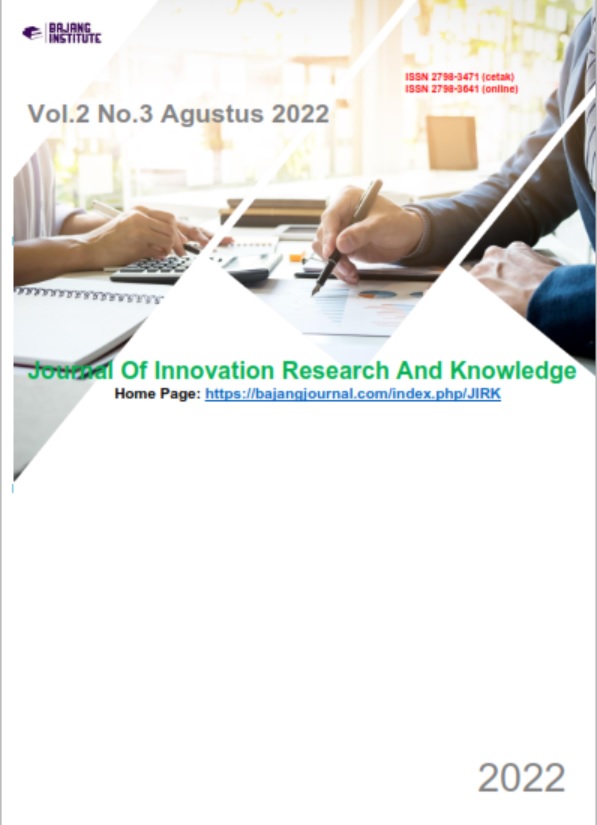RELATIONSHIP BETWEEN ANXIETY LEVELS AND SLEEP QUALITY OF ASTHMATICS
DOI:
https://doi.org/10.53625/jirk.v2i3.3143Keywords:
Asthma, Anxiety Level, Sleep Quality, Asthma SufferersAbstract
Asthma is a chronic airway disease that is found throughout the world with varying frequency associated with increased airway sensitivity that triggers episodes of repeated wheezing, shortness of breath, chest tightness, dyspnea and coughing. (cough) especially at night or early morning. Anxiety can also be a heavy burden that causes the individual's life to always be under the shadow of prolonged anxiety and considers anxiety to be a mental strain accompanied by a disturbance in a person's sleep patterns that can easily change or experience a sleep disorder as a result of anxiety in his sick condition or hospital routine. The purpose of this study was to determine the relationship between Anxiety Levels and Sleep Quality of Asthmatics.
The design of this study used the Correlational Cross Sectional Analytic method with Non Probality Sampling technique with Quota Sampling type, with a population of 25 patients with asthma and a total sample of 25 people, while data collection using interviews guided by a questionnaire. Results are presented in tabular and narrative form.
The results of the study the relationship between anxiety levels with sleep quality of asthmatics indicates that there is a very strong relationship between anxiety levels and sleep quality in asthma patients in Moncek puskesmas with a correlation coefficient of 0.664 with a significance (p value) of 0,000.
Seeing the results of this study it is recommended for the health center to be able to create a comfortable environment, especially to limit the skating or drapery in the patient's room and to limit the patient's visit time so that the patient's sleep is not disturbed.
References
Alimul H, Aziz.2019, Pengantar Kebutuhan Dsara Manusia. Jakarta: Salemba Medika.58
Asmadi.2009. Konsep dan Aplikasi Kebutuhan Dasar Klien.Jakarta. Salemba Medika:143
Carpenito, L. J. 2012. Diagnosa Keperawatan: Aplikasi pada Praktek Klinik .Edisi 6. Jakarta: EGC.
Detiana, P. (2014). Mengatasi Rasa Gejala Kecemasan. Yogyakarta:
Eka, Sulistiawati. (2016). Cara Tepat Menghilangkan Kecemasan Anda. Jakarta;
GINA (Global Initiative for Asthma). (2016),. Pocket Guide for Asthma Management and Prevension in Children.:134-139
Ghufron M. Nur dan Wati S, Rini.2012, Cara Tepat Menghilangkan Kecemasan Anda. Yogyakarta: Galang Press:42
Ginsberg D., 2019. An Unidentified Monster in the Bed-Assesing Nocturnal Asthma in Children. McGill Journal of Medicine. 12(1):31-38
Hadibroto, Iwan & Syamsir Alam. (2014). Asma. Jakarta: Penerbit PT Gramedia Pustaka Utama:24-26
Iskanda,J . 2015. Fakultas Kesehatan Universitas Sumatera Utara
Jamaris, Martini. 2012. Perkembangan dan Pengembangan Anak Usia Taman Kanak-kanak. Jakarta: Gramedia
Khasanah K dan Hidayat W.2012. Kualitas Tidur Lansia Balai Rehabilitaasi Sosial”MANDIRI” Semarang Jurnal Nursing Studies 1 (1) : 189
Nancy W, 2013. Wake Up to The Healling Properties of Sleep:12-15
Notoadmodjo. 2014. Metode Penelitian Kesehatan. Rineka Cipta: Jakarta
Nursalam (2013). Metodologi Penelitian Ilmu Keperawatan: Salemba Medika. Jakarta
Nursalam. (2016). Metodologi Penelitian Ilmu Keperawatan: Pendekatan Praktis. Edisi 4. Jakarta: Salemba Medika.
Potter & Perry. 2014. Buku Ajar Fundamental Keperawatan: Konsep, Proses dan Praktik. Jakarta: EGC.:5-6
Potter & Perry. (2015).Fundamental of Nursing.Mosby.st.Louis:11
Ramaiah, Savitri. 2013. Asma Mengetahui Penyebab Gejala dan Cara Penanggulangannya. Jakarta: Bhuana Ilmu Populer:24-26
Sundaru H, Sukamto. (2012) Asma Bronkial, Departemen Ilmu Penyakit Dalam Fakulas Kedokteran Universitas Indonesia, Jakarta:57-59
Susanne M, Steven G. Normal Sleep, Sleep Physiology, and Sleep Deprivation. [Cited 2011Dec 20]:11
Taylor, M. (2014). Cara Tepat Menghilangkan Kecemasan Anda, Jakarta















